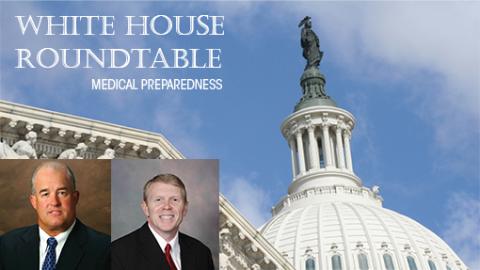
On April 29, 2015, NATA President Jim Thornton, MA, ATC, CES, and NATA Hall of Famer Ron Courson, ATC, PT, NREMT-I, CSCS, traveled to Washington, D.C. after being invited to participate in a White House Roundtable. The goal of the forum was to build national resilience by providing information and tools the general public can use to save lives.
The Roundtable included 50 senior leaders from 35 national organizations representing 9-1-1, allied health disciplines, emergency management, EMS, fire service, law enforcement, medicine, nursing and public health along with key federal personnel and National Security Council (NSC) staff, who gathered to discuss a national initiative, Bystanders: Our Nation’s Immediate Responders. This medical-preparedness initiative is a direct response to Presidential Policy Directive 8 (National Preparedness), and the meeting was held at the Eisenhower Executive Office Building at the White House.
The goal of the initiative is to build national resilience by better preparing the general public to save lives by raising awareness of techniques that can save lives by taking such basic actions as stopping life threatening bleeding. National preparedness is the shared responsibility of all levels of government, the private and nonprofit sectors, and individual citizens. As we have seen in such recent tragic incidents as the Boston Marathon bombings, anyone can contribute to safeguarding the nation from harm. At the meeting, convened by the NSC staff, members of the federal interagency Bystander Workgroup reviewed progress on the initiative and received valuable input from participants. There was unanimous support for the Bystander initiative from the participants.
“NATA has had a longstanding commitment to medical preparedness, prevention and treatment of injuries and illnesses with regard to physical activity and sports participation across the lifespan,” said Thornton. “We were honored to offer critical insights that can help save lives and reduce the onset of acute, chronic or fatal outcomes.”
“We were able to offer a vital sports medicine safety perspective,” added Courson, who has contributed to many of NATA’s statements with regard to emergency planning. “Ensuring the health and welfare of those who are physically active or involved in sports was a critical component [of the Roundtable].”
Participating Organizations:
Air Medical Physician Association
American Academy of Physician Assistants
American Ambulance Association
American Association of Critical-Care Nurses
American Association for the Surgery of Trauma
American College of Emergency Physicians
American College of Surgeons
American Heart Association
American Hospital Association
American Nurses Association
American Osteopathic Association
American Physical Therapy Association
American Public Health Association
American Trauma Society
Association of Air Medical Services
Association of State and Territorial Health Officials
Eastern Association for the Surgery of Trauma
Emergency Medical Services Labor Alliance
Emergency Nurses Associatio
International Academies of Emergency Dispatch
International Association of Chiefs of Police
International Association of Emergency Managers
International Association of Emergency Medical Services Chiefs
International Association of Fire Chiefs
International Association of Fire Fighters
Major Cities Chiefs Association
National Association of Emergency Medical Services Technicians
National Association of School Nurses
National Association of State EMS Officials
National Athletic Trainers’ Association
National Emergency Management Association
National Volunteer Fire Council
Society of Emergency Medicine Physician Assistants
Society of Trauma Nurses
Trauma Center Association of America
Federal Departments and Agencies Represented:
Combat Casualty Care Research Program and Office of the Assistant Secretary of Defense, Homeland Defense & Global Security, Department of Defense
Federal Bureau of Investigation, Department of Justice
Office of the Assistant Secretary for Preparedness and Response, Department of Health & Human Services
Federal Emergency Management Agency and Office of Health Affairs, Department of Homeland Security
National Highway Traffic Safety Administration, Department of Transportation
Office of Medical Services, Department of State
National Security Council Staff
Physician to the President
Physician to the Vice President
Posted by NATA Communications Manager Jordan Grantham (jordang@nata.org)





